Loving the Highlife in Crestwood Hills - Los Angeles
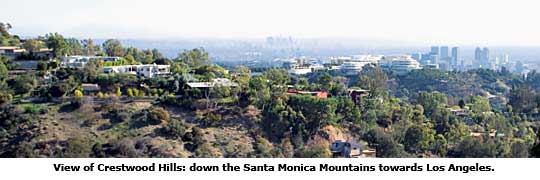
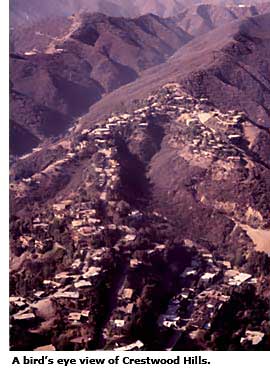
Few neighborhoods have gotten underway with grander plans than Crestwood Hills. Imagine a place where hardworking musicians, teachers, and writers can live together, close to the city yet surrounded by nature, with cooperatively owned schools, stores, medical services—and even a bus to take them to their jobs in Los Angeles.
Such was the dream. And some of it came true.
"It was very exciting, I have to say," says Nora Weckler, who joined the Mutual Housing Association, which in the late 1940s developed the site in the then-remote Santa Monica Mountains high above Sunset Boulevard.
The association, initially founded by a small group of studio musicians, hired a design team headed by architect A. Quincy Jones, who later designed houses for Northern California-based developer Joe Eichler. The architects came up with a neighborhood of modern homes, each expertly fit into its hillside location.
"I was very impressed and loved the design of the houses," Weckler says. "They were glass and redwood and concrete blocks—a lot of glass. It felt very open. The way the property was designed, the landscaping, the architecture, it still had that feeling of country to it. No house around us was on the same level. They just didn't bulldoze and flatten the land out and make it easy to build on. Every house was designed for the lot, and made it seem very private."
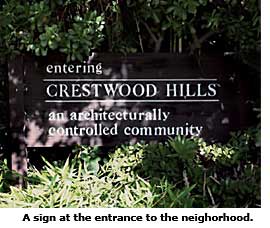
"Everybody there was kind of idealistic," she recalls. "It was politically leftist. And people I think were very comfortable with one another."
But few modern neighborhoods have had as many ups and downs as Crestwood Hills—in part because the terrain itself has so many ups and downs. Tracts of modern homes are not rare. But it is rare that you'll find one built atop mountainous ridges, which are usually reserved for custom-designed homes—or bobcat and deer.
Harold Zellman and Roger Friedland, who wrote a wonderful historical account of the neighborhood, claimed that it unveiled "a new architectural form—hillside modern."
The first of the neighborhood's downs came quickly. The association's grand plans never reached fruition due to financial problems that were due, in part, to the expense of building on the hilly site. The original plan called for 500 homes on 800 acres. Only 160 got built, and much of the land was sold off.
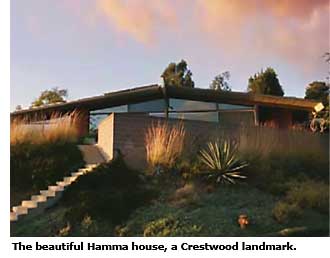
The second? On November 6, 1961, a wildfire driven by 50 mile-per-hour winds raced through the mountains, destroying more than 60 of the Jones-designed homes, as well as many others (but taking no lives).
Then, in the years that followed, many more of the Mutual homes were lost—not to fire this time, but to insensitive remodeling and demolitions.
By the time architect Cory Buckner arrived on the scene, in 1994, only 45 of the remaining 100 homes retained their architectural integrity. That gradually dropped to 33.
"My husband and I said, we need to bring them in as historic monuments," Buckner says. So began the neighborhood's latest upswing. Over the next few years, Buckner convinced 17 residents to have their homes designated as Los Angeles 'historic-cultural monuments.' As an architect, she has also remodeled a dozen homes in the neighborhood, all in keeping with the original architecture. Buckner's own house, which originally served as Mutual Housing's architectural office, is one of the most dramatic, floating across its site on a bridge of steel.
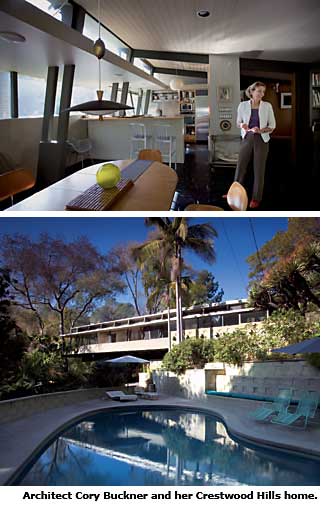
Buckner has been helped by the newfound interest in mid-century modern architecture. When she first arrived, people buying in Crestwood didn't care about the original architecture, she says.
"People who buy them today buy them on purpose," says Lizzy Bentley O'Neal, who bought her home in 2007 because of her husband's interest in the architecture, and her interest in the good schools.
"This is clearly one of the most significant postwar modern residential neighborhoods in Los Angeles, both for its architecture, the design of its individual buildings and its overall tract design, and for its association with the model of cooperative housing and the social ideals associated with that," says Ken Bernstein, director of Los Angeles' Office of Historic Resources, who applauds Buckner's efforts.




